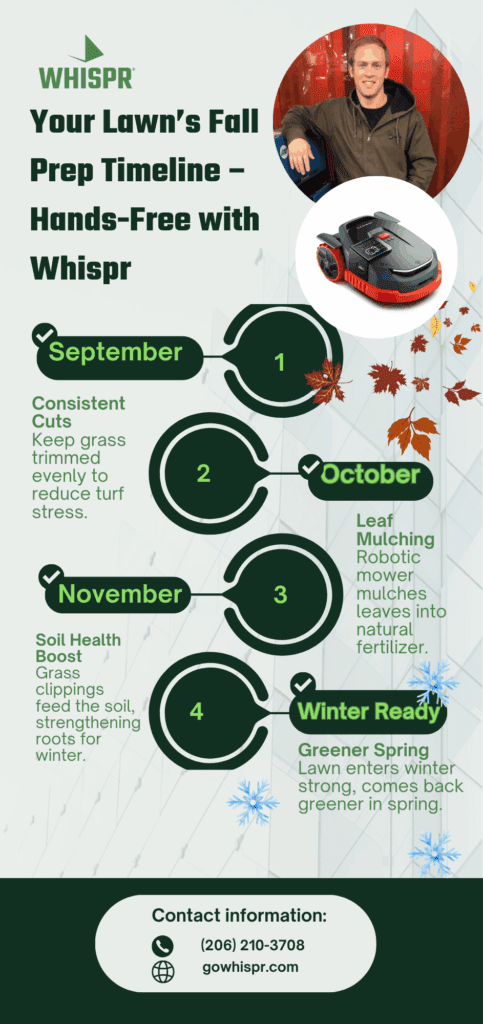Why Do Homeowners Feel “Yard Fatigue” in Fall?
By September, most Idaho homeowners are tired of mowing. The novelty of spring planting is long gone, and family and school commitments now fill the weekends. Spending another Saturday pushing a gas mower isn’t appealing.
Fall is the tipping point when homeowners ask:
“Is there a smarter way to keep my yard looking its best?”
What’s Wrong with Traditional Mowing?
Gas-powered mowers may work—but at a cost:
- Noise pollution: Traditional mowers average 85–90 decibels—loud enough to disturb neighbors.
- Air pollution: One hour of mowing = driving a car 100 miles.
- Time drain: 20 to 40 hours per season—nearly a full workweek.
For busy families and eco-conscious homeowners, the drawbacks outweigh the benefits.
What Makes Robotic Lawn Mowers Different?
Whispr robotic mowing delivers smarter, cleaner lawn care:
- Always-on schedules: Daily micro-trims keep lawns perfectly groomed.
- Quiet operation: Under 60 decibels—quiet enough to run while you relax.
- Zero emissions: Battery-powered with no gas or fumes.
- Healthier turf: Micro-cuts return nutrients to the soil.
Not just a replacement—an upgrade in sustainability and results.
Why Fall Is the Perfect Time to Switch
Fall offers ideal conditions for robotic mowing:
- Cooler temps reduce turf stress.
- Consistent cut height prepares lawns for winter.
- Mowers mulch leaves into nutrient-rich soil.
- Keeps your lawn trimmed and winter-ready—while neighbors dread the last mow.
How Much Does Robotic Mowing Save?
Traditional lawn care:
- Fuel costs: $5–$10 per mow × 25 sessions = up to $250.
- Maintenance: Oil, spark plugs, belts = $100+/year.
- Time: 30 hours per season = ~$1,200 if valued at $40/hour.
With Whispr:
- No gas or oil.
- Minimal maintenance.
- Time back for what matters most.
The real ROI? Weekends reclaimed.
How Does WHISPR’s Wireless System Work?
Forget buried wires. Our tech is more innovative:
- GPS navigation = complete coverage.
- Mobile app control = check status anytime.
- Fleet scalability = perfect for large or complex lawns.
Can Robotic Mowers Handle Idaho Terrain?
Yes. Whispr adapts to your property with:
- Property assessment for slopes & obstacles.
- Digital mapping for exact boundaries.
- Docking station setup.
- Calibration run for accuracy.
Handles uneven ground and leaf drop with ease.
Are Robotic Mowers Safe for Families?
Absolutely. Safety features include:
- Child and pet sensors: Auto blade stop on contact.
- No gas storage: Safer for garages and sheds.
- Allergy-friendly: Frequent trims reduce pollen buildup.
Sustainable and safe for family backyards.
What Happens in the First Month?
Most users see results in 4 weeks:
- Week 1: Light trimming + system calibration.
- Week 2: Full mowing cycles begin.
- Week 3: Adjustments for terrain and fall leaf drop.
- Week 4: Lush, even lawn with zero effort.
What Do Idaho Homeowners Say?
“By October, I was done mowing. Installing a robotic mower gave me back my weekends.” – Rigby homeowner.
“The quiet operation blew me away. We host backyard dinners while it runs.” – Idaho Falls family.
“Our lawn looked better within weeks. Smartest fall investment we made.” – Rexburg resident
Ready to Go Hands-Free?
This fall, don’t let yard fatigue win. With Whispr, you get:
- Greener lawns
- Quieter weekends
- Smarter care
Reserve My Fall Setup – Limited spots available in Rigby, Rexburg, and Idaho Falls.

FAQs
Can robotic mowers handle leaves in the fall?
Yes. Whispr mowers mulch small leaves into the soil, reducing cleanup and improving lawn health.
Are robotic mowers safe around kids and pets?
Absolutely. Built-in sensors stop blades instantly on touch or lift.
What happens in winter?
We store your mower indoors. Spring reactivation is quick and hands-free.
More Seasonal Insights
Looking for lighting trends or turf tips?
Visit our Eco-Friendly Outdoor Living Blog

